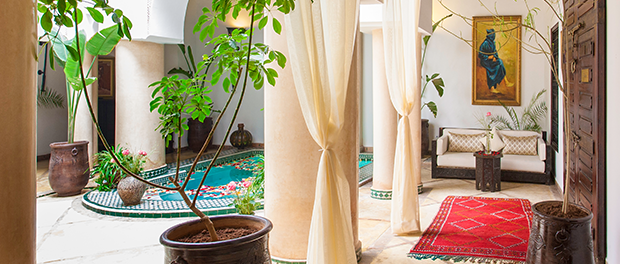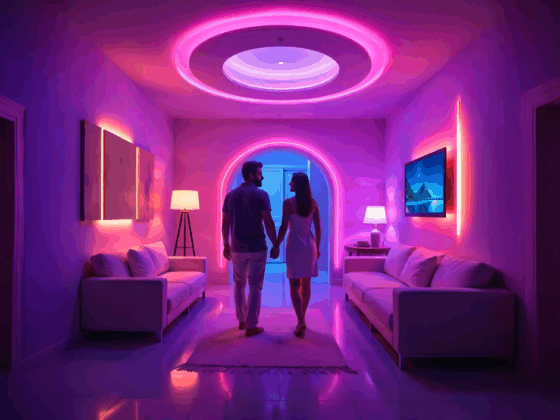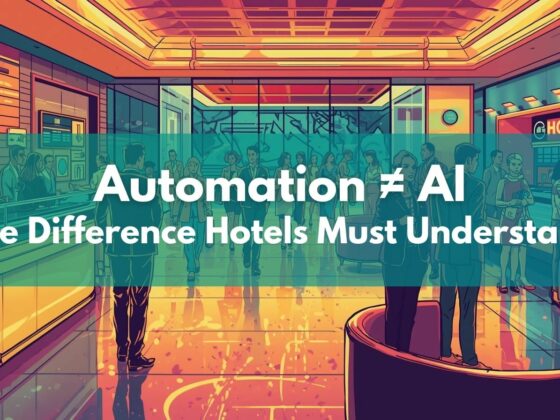An interview with landscape architect Victoria Cobeña on creating sustainable, experience-driven hotel outdoor spaces.
Introduction
Hotel outdoor spaces are no longer an afterthought; they are now central to the guest experience. These sophisticated extensions of the hotel brand must deliver on aesthetics, efficiency, and sustainability. The key is fusing landscape architecture with smart technology to create memorable, resilient environments. This involves creating living systems that adapt to seasons, guest flows, and environmental conditions. To delve deeper, Shiji Insights spoke with landscape architect Victoria Cobeña. Her forward-thinking work blends natural beauty with hidden tech, revealing how hotels can transform outdoor assets into powerful drivers of value.
Takeaways
Engage landscape architects from day one. Early collaboration prevents costly errors and unlocks your property’s true outdoor potential.
Use technology to amplify authenticity, not replace it. Smart tools help communicate a unique design vision rooted in place.
Think of sustainability as a whole system. Combine smart plant choices with unseen designs for soil and water management.
Smart microclimate design extends the usable season. This directly impacts guest comfort and increases valuable F&B revenue.
Create magic by hiding the infrastructure. Concealing tech like lighting and sound enhances the natural guest experience.
How does early integration of landscape architecture enhance the cohesion between indoor and outdoor spaces in hotel developments? I’m particularly interested in your collaboration with building architects to align functionality and aesthetics.
Traditionally, landscape design was an afterthought, with plants used as mere decoration to fill predefined spaces. This outdated mindset leads to “greenwashing” and misses the true potential of outdoor areas. When we are involved early, we can go “beyond greening” by designing landscapes that function as beautiful, living infrastructure. Early collaboration is crucial to avoid costly, irreversible errors. For instance, without expert input, architects might design features incompatible with a site’s topography or the needs of mature trees, losing unique natural assets. Our primary role is to shape environments where life can thrive, creating a holistic system that benefits the hotel, the guest, and the environment.
The real value we bring is our expertise in living systems, climate, soil, water, and sunlight, which complements the building architect’s focus on inert materials. This powerful collaboration creates habitats, not just spaces, which deeply resonates with today’s environmentally conscious guests and aligns with essential sustainability goals. Furthermore, this early input has tangible benefits, from shaping the plot to optimize microclimates to adjusting building levels to reduce construction costs and carbon footprints. Ultimately, this expert-led approach ensures that the hotel’s green spaces are not only cohesive and beautiful but also efficient to maintain long-term.
What role does technology play in visualizing seasonal changes and their impact on hotel outdoor areas? Can you provide an example of how 3D modeling or simulation influenced a project decision?
Technology is essential for creating a premium guest experience. Our goal is to design memorable outdoor spaces. These spaces evolve with the seasons. They give guests a new experience with each visit. This encourages them to return. We use 3D modeling and simulations. This clarifies our vision for hotel management. It adds significant value to their decision-making process. Crucially, these tools expand, not replace, our hands-on work. True authenticity is born from analog methods. This includes sketching and observing the site’s unique light. Technology then translates these feelings into a design that can be built.
A key application of this is designing for seasonality. We develop fully customized planting databases for each project. We link climate data, colors, and plant behaviors. This data connects to 2D and 3D models. We use specialized software to design intricate planting mixes. We also get live feedback on their performance throughout the year. This ensures no season feels weak or overlooked. These simulations make the complexity of our work visible. They demonstrate a purposeful and curated approach. This approach goes far beyond random greenery.
Furthermore, technology plays a crucial role in aligning expectations. It also supports informed financial decisions. We combine 3D modeling with data. This visually demonstrates investment impacts. We demonstrate how initial plant sizes impact both cost and appearance. This is shown for opening day versus several years later. This is specific to working with living organisms. It helps the hotel team make smart choices. They can balance immediate visual impact with their budget. They also balance it with their long-term property vision.


How can smart irrigation and water monitoring systems reduce hotel operational costs while supporting sustainability goals? Using moisture and humidity sensors, how do these contribute to long-term landscape health and maintenance?
Smart irrigation technology alone has a limited impact on operational costs and sustainability. Its effect is truly multiplied when combined with landscape design principles that improve soil health over time. The first and most important step is selecting plants that “naturalize” to the local climate, as these species require very little water once established. Just as crucial is designing what lies beneath the surface, the unseen layers of soil that dictate how water is stored, drained, and used.
We create a resilient foundation by engineering the soil itself. This involves specifying appropriate soil depth and incorporating hidden layers that act as water reservoirs, such as modular retention cells or structured gravel layers. These store excess water from rain or irrigation and release it slowly as the ground dries. We then add a layer of mulch on the surface, which significantly slows evaporation. Over time, this stratification creates healthier soil that retains moisture far more effectively on its own.
Only when this smart soil system is in place do we amplify its efficiency with technology. Moisture sensors monitor real-time conditions, activating irrigation with precision only when necessary. This data also allows us to track the performance of different planting mixes, refining our schemes over time to be even more resilient. This transforms maintenance into a responsive, intelligent process. Drastically reducing water costs, minimizing plant replacement, and taking sustainability to a regenerative level by improving the site’s original conditions.
Hotels can utilize water recycling and greywater processing to promote sustainability and comply with local regulations. How can they take advantage of these systems?
We treat rainwater and purified grey or blackwater as one of our most valuable resources, not as waste. This approach enables hotels to meet their sustainability goals and emerging regulations while creating beautiful, climate-resilient spaces. Our innovation lies in collaborating with engineers to reverse the traditional practice of hiding and discarding water. Instead, we bring this water to the surface, using it to create landscapes full of life and turning a liability into a central feature of a circular, resilient system.
In practice, we purposefully design gardens and patios to direct this recycled water through open channels into designated basins. These can become aesthetic features like artificial wetlands that boost biodiversity and cool the air, or temporary ponds that allow for slow soil infiltration and storage. This strategy is becoming essential. Evolving regulations, such as the EU Water Reuse Regulation, which is now in effect, and severe droughts in tourist areas of Spain and Greece, make on-site water circularity a vital asset for environmental and operational resilience.
The benefits of this approach are comprehensive. Environmentally, it reduces pressure on freshwater sources, mitigates the impacts of both floods and droughts, and promotes soil health. For the business, it enhances ESG performance, facilitates the attainment of green certifications, and attracts eco-conscious guests and investors. Ultimately, it enhances the guest experience by utilizing water to cool outdoor spaces, adding sensory appeal, and making the hotel’s commitment to environmental stewardship visually apparent.


You’ve mentioned designing for microclimates. How can this concept extend the usable season for hotel outdoor venues or F&B spaces?
My experience in extreme climates, from the cold of Norway to the heat of the Greek islands, has taught me the importance of designing for microclimates. By applying a few key climatic principles, we can make hotel outdoor spaces usable for much longer periods of the year, significantly increasing the value of F&B venues and lounges. Disregarding these basics can lead to discomfort regardless of the season, but a thoughtful design can manipulate the environment to extend guest comfort and the operational calendar.
The techniques are practical and targeted. In colder climates, we create warmth by placing sitting areas next to dark, south-facing walls that absorb and radiate heat, and by using vegetation as windbreaks. Conversely, in hotter climates, we create a sense of coolness. Deciduous trees and pergolas with climbers provide shade in summer but allow welcome sunlight in winter. Furthermore, strategically placed water features can cool the air through evaporation, an effect that is amplified by aligning them with prevailing breezes.
How do your projects use smart lighting with sensors to enhance the hotel experience for guests while minimizing light pollution and protecting wildlife?
When lighting outdoor areas, our philosophy is “Less is More,” as planning for shadows is just as important as planning for light. We aim for a careful balance that enhances the natural night sky, rather than creating overwhelming light pollution that discomforts both guests and wildlife. To achieve this, we work with curated “layers of light,” establishing hierarchies to create specific ambiences. We also avoid disruptive uplights, preferring nature-based effects like a subtle “full moon” glow that minimizes sky pollution and creates a more atmospheric feel.
Sensors are key, but we use them in a way that protects wildlife from sudden changes. Instead of a space being completely dark until activated, we establish a very subtle “basic layer” of light to create a calm, constant ambience. Sensors then activate a second, functional layer of light only when needed, such as along a pathway. For periods of high traffic, we recommend adjusting the constant light level slightly rather than relying on frequent, disruptive sensor activations.
Dimmers are just as crucial as sensors and are incredibly powerful when used in combination. Not all nights are equally dark, and a dimmer-sensor combo allows us to adapt the lighting intensity to the ambient moonlight, whether it’s a bright full moon or a cloudy night. This technology provides ultimate control and flexibility, enabling the lighting scheme to be perfectly tailored for different atmospheres, from intimate dinners to special hotel events.
What new technologies will change how hotels manage their outdoor spaces? Are there exciting innovations in AI, climate tech, or sensors?
My creative process is a blend of the analog and digital worlds. I believe that authentic, special projects are always sparked by irreplaceable “analog methods”, my personal impressions from visiting a site, mapping its unique atmosphere, and conversations with the people there. For me, technology is not the source of the idea, but the essential tool I use to translate these feelings and observations to my design table. It allows me to design for the senses and create connections with nature in a more sustainable and respectful way.
Looking forward, I am excited by two key technological frontiers. One is the potential for simulations to go beyond the visual, perhaps using VR to replicate scents and sounds to test the feelings a design will evoke. Even more exciting, however, is the future of accessible monitoring. Imagine affordable apps that use real data to prove the positive impact of our work, quantifying increases in biodiversity, water saved, or temperature reductions. If we can easily demonstrate this value, I am hopeful that sustainable, thoughtful design will become the norm in hospitality, not the exception.
Final Words
Victoria emphasizes a critical shift in hospitality design. Outdoor spaces are no longer static backdrops. They are dynamic, intelligent environments. They contribute actively to the guest experience, operational bottom line, and environmental health. The thoughtful integration of hidden technology is the catalyst for this transformation. It enables the creation of landscapes that are responsive, resilient, and deeply connected to their surroundings. As hotels continue to seek differentiation, the intelligent design of their outdoor spaces offers a powerful and authentic path forward. It is a path where visible impact is born from technology that is seamlessly woven into the fabric of the natural world.
[embedded content]









